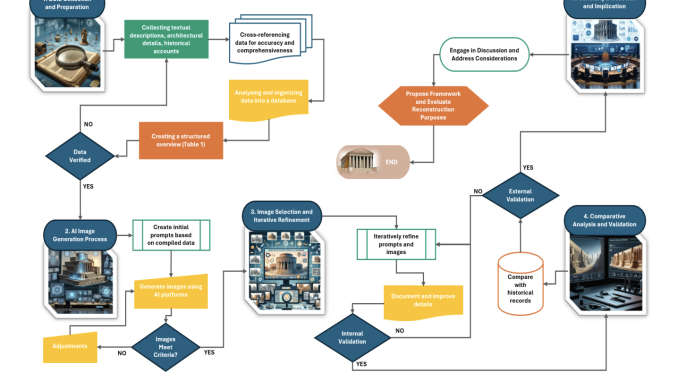
The world’s cultural heritage faces mounting peril from escalating conflicts and natural disasters, jeopardizing ancient sites and artifacts worldwide. Wars, earthquakes, and floods pose existential threats, imperiling invaluable pieces of history. Urgent action is needed to protect these sites. Artificial intelligence (AI) presents a potent solution, providing sophisticated tools to document, analyze, and safeguard cultural heritage. By harnessing AI, we can significantly enhance our ability to mitigate these risks and ensure the preservation of our global heritage for generations to come.
AI methods such as text-to-image systems (e.g., Midjourney, DALL-E), 3D and 2D modeling tools (e.g., ArchiCAD, AutoCAD), generative adversarial networks (GANs) for image super-resolution, and machine learning algorithms are transforming the preservation and reconstruction of cultural heritage. These technologies enable the creation of detailed digital replicas from textual descriptions and historical records, enhance visualization accuracy, and provide spatial data through photogrammetry and UAV-based 3D reconstruction. These advancements are crucial for protecting and digitally restoring heritage sites threatened by conflicts and natural disasters.
In this context, a research team from Runel University London proposed a novel method using AI-driven text-to-image generation to reconstruct damaged heritage sites. Unlike traditional approaches relying on physical remnants, this method utilizes detailed textual descriptions from historical and archaeological sources to create accurate visual representations. By generating images closely resembling the original structures through precise text prompts, this innovative approach enhances digital heritage preservation by bridging historical documentation with advanced AI capabilities.
In more detail, the authors proposed to follow the following approach in their methodology:
First, they collect and organize textual descriptions, architectural details, and historical records from various scholarly sources to ensure a comprehensive dataset categorized, which serves as the foundation for generating accurate textual prompts.
Next, employing advanced AI platforms like Midjourney and DALL-E, they convert these detailed textual prompts into visual reconstructions of the heritage sites. This AI image generation process involves iterative refinement, where initial images are produced and refined based on feedback and validation from historical experts and archaeological data.
Following the generation of AI-driven images, the methodology includes a critical phase of image selection and iterative refinement. The AI-generated images are rigorously evaluated against historical benchmarks and validated for accuracy and fidelity. This phase ensures that the digital reconstructions closely align with the architectural and cultural contexts of the original heritage sites.
The research team rigorously evaluated their technique through real-world scenarios, employing a multidisciplinary approach with historians, archaeologists, and cultural experts to refine AI-generated imagery. Their collaboration aimed to ensure the reconstructions’ accuracy and authenticity against historical and cultural standards. The experiment utilized two methodologies: firstly, a historical accuracy check cross-referencing AI-generated images with historical records and literature to maintain contextual fidelity, and secondly, quantitative metrics evaluation using SSIM, MSE, PSNR, and MAE to measure similarity to original references. Testing across sites like Pompeii, Petra, and the Parthenon confirmed AI’s ability to faithfully depict intricate historical details and architectural remains, highlighting ethical considerations for AI’s responsible use in cultural contexts. These results underscored AI’s technological advancements in preserving and visualizing cultural heritage, suggesting fruitful paths for interdisciplinary research and future applications.
In conclusion, the paper presented in this article demonstrates AI’s significant potential in cultural heritage preservation through accurate digital reconstructions of sites like the Giant Buddha statue. Utilizing AI-generated imagery and rigorous evaluation metrics confirms the fidelity of reconstructions. Integrating AI with traditional methods offers a balanced approach to conserving and revitalizing cultural legacies. Addressing data quality and algorithm refinement challenges is crucial for enhancing AI’s precision in heritage conservation. Collaborative efforts with experts ensure technically accurate and culturally nuanced digital reconstructions, advancing ethical standards. Ultimately, AI-driven digital engagement promises broader accessibility and educational opportunities, enriching our understanding and appreciation of cultural heritage.
Check out the Paper. All credit for this research goes to the researchers of this project. Also, don’t forget to follow us on Twitter.
Join our Telegram Channel and LinkedIn Group.
If you like our work, you will love our newsletter..
Don’t Forget to join our 46k+ ML SubReddit
Mahmoud is a PhD researcher in machine learning. He also holds abachelor’s degree in physical science and a master’s degree intelecommunications and networking systems. His current areas ofresearch concern computer vision, stock market prediction and deeplearning. He produced several scientific articles about person re-identification and the study of the robustness and stability of deepnetworks.





Be the first to comment